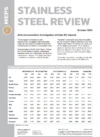Nickel prices soar amid market panic
LME nickel prices closed at more than US$42,000 per tonne on Monday March 7, 2022. The following morning, values briefly soared above US$100,000 per tonne before dropping to near US$80,000 per tonne, during a frenzied early morning session. The LME suspended trading at this point and has now cancelled all nickel trades that took place on March 8, 2022.
This was not a move without precedent. Concerns about a repeat of the 1985 tin market crisis are evident. Back then, backwardation was restricted, as it was for nickel on Monday. Trading of tin was also suspended not long afterwards, as is the case again with nickel, this time around. Although the precursor to this occurring is different, parallels can still be drawn. Any resultant payment defaults could lead to catastrophic consequences in the financial sector.
Many in the market are asking what caused the sudden spike in nickel prices and subsequent pause in trading activities on the London Metal Exchange. There is speculation surrounding a significant short position and the likelihood of a default by one, or more, traders. This seems to be behind the LME’s decision to halt the nickel contracts. How long the suspension will remain in place is yet to be determined.
Sanctions against Russia, by many countries around the world, have led to the escalation of nickel supply fears, this week. Russia is the third largest producer of nickel, accounting for almost 10 percent of global output. This has caused nickel prices to skyrocket.
With demand for nickel from the stainless steel and electric vehicle battery sectors running high, shortages were already evident in the market, prior to the recent supply woes. Inventories held in LME warehouses have fallen by 70 percent, compared with one year ago. Cancelled warrants have risen from more than 23 percent to above 50 percent, in the same period. This has left very little in stock at the LME approved locations. However, reserves remain above the low levels recorded during the 2007 price spike.
Buyers fear impact on stainless market
The crisis in the commodity industry will, almost certainly, filter through to the stainless steel market.
The average nickel price during the March alloy surcharge reference period was approximately US$23,500 per tonne. A nickel price of US$80,000 per tonne would represent a rise of US$56,500 per tonne, if trading resumed and prices stayed at around that level for the remainder of the April reference period. This would add a staggering €4500 per tonne, or more than US$5400 per tonne, to grade 304 alloy surcharges, next month. To put this into perspective, the average March surcharge for the same product is less than €2700 per tonne, in Europe, and around US$2900 per tonne in the US.
Ferrochrome, molybdenum and ferrous scrap values are also increasing. These, coupled with escalating energy prices, are adding to rising costs for stainless steel manufacturers and their respective customers.
Stainless steel buyers are now scrambling to make sense of what this all means for their businesses. Record high prices could lead to demand destruction across the global industry. Credit limits are currently insufficient to accommodate prices at much higher levels than they are now. How many customers will be willing, or able, to pay the additional costs remains to be seen. Mills are also unlikely to be able to absorb the sudden jump in their input expenditure. This could lead to question marks surrounding the survival of many companies, in the coming weeks and months.
One thing is certain, volatility in the stainless steel market will ensue. Significant price rises are now predicted for buyers in all regions.

Source:
Stainless Steel Review
The MEPS Stainless Steel Review is an invaluable monthly guide to international stainless steel prices and includes the latest global stainless steel industry analysis.
Go to productRequest a free publication





